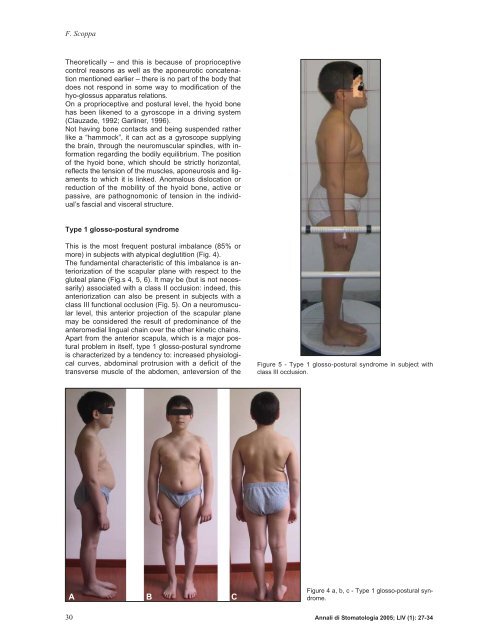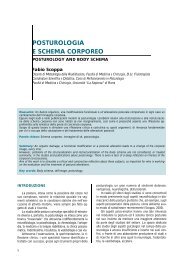Glosso-postural syndrome
Glosso-postural syndrome
Glosso-postural syndrome
Create successful ePaper yourself
Turn your PDF publications into a flip-book with our unique Google optimized e-Paper software.
F. Scoppa<br />
Theoretically – and this is because of proprioceptive<br />
control reasons as well as the aponeurotic concatenation<br />
mentioned earlier – there is no part of the body that<br />
does not respond in some way to modification of the<br />
hyo-glossus apparatus relations.<br />
On a proprioceptive and <strong>postural</strong> level, the hyoid bone<br />
has been likened to a gyroscope in a driving system<br />
(Clauzade, 1992; Garliner, 1996).<br />
Not having bone contacts and being suspended rather<br />
like a “hammock”, it can act as a gyroscope supplying<br />
the brain, through the neuromuscular spindles, with information<br />
regarding the bodily equilibrium. The position<br />
of the hyoid bone, which should be strictly horizontal,<br />
reflects the tension of the muscles, aponeurosis and ligaments<br />
to which it is linked. Anomalous dislocation or<br />
reduction of the mobility of the hyoid bone, active or<br />
passive, are pathognomonic of tension in the individual’s<br />
fascial and visceral structure.<br />
Type 1 glosso-<strong>postural</strong> <strong>syndrome</strong><br />
This is the most frequent <strong>postural</strong> imbalance (85% or<br />
more) in subjects with atypical deglutition (Fig. 4).<br />
The fundamental characteristic of this imbalance is anteriorization<br />
of the scapular plane with respect to the<br />
gluteal plane (Fig.s 4, 5, 6). It may be (but is not necessarily)<br />
associated with a class II occlusion: indeed, this<br />
anteriorization can also be present in subjects with a<br />
class III functional occlusion (Fig. 5). On a neuromuscular<br />
level, this anterior projection of the scapular plane<br />
may be considered the result of predominance of the<br />
anteromedial lingual chain over the other kinetic chains.<br />
Apart from the anterior scapula, which is a major <strong>postural</strong><br />
problem in itself, type 1 glosso-<strong>postural</strong> <strong>syndrome</strong><br />
is characterized by a tendency to: increased physiological<br />
curves, abdominal protrusion with a deficit of the<br />
transverse muscle of the abdomen, anteversion of the<br />
A B C<br />
Figure 5 - Type 1 glosso-<strong>postural</strong> <strong>syndrome</strong> in subject with<br />
class III occlusion.<br />
Figure 4 a, b, c - Type 1 glosso-<strong>postural</strong> <strong>syndrome</strong>.<br />
30 Annali di Stomatologia 2005; LIV (1): 27-34



